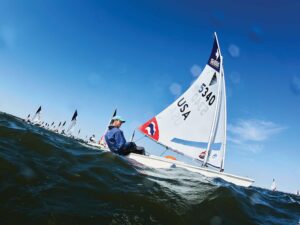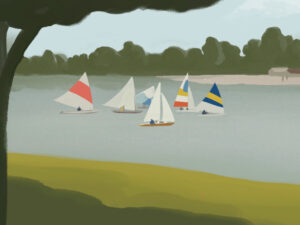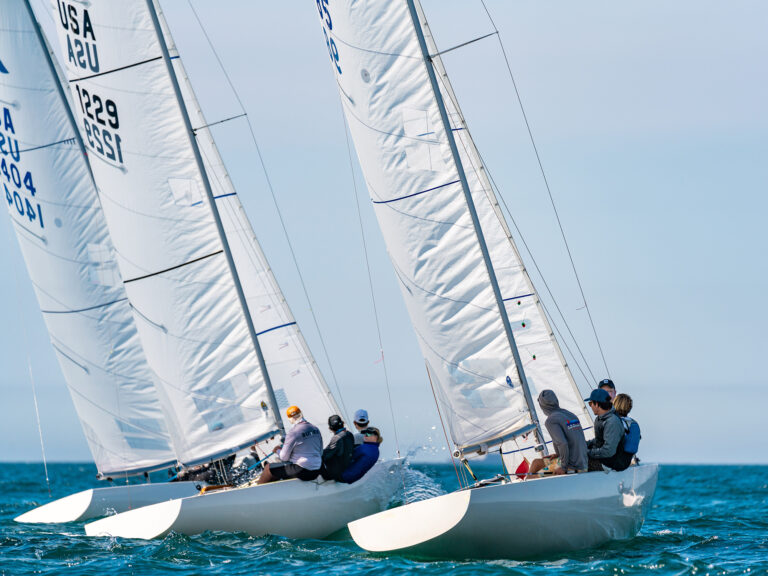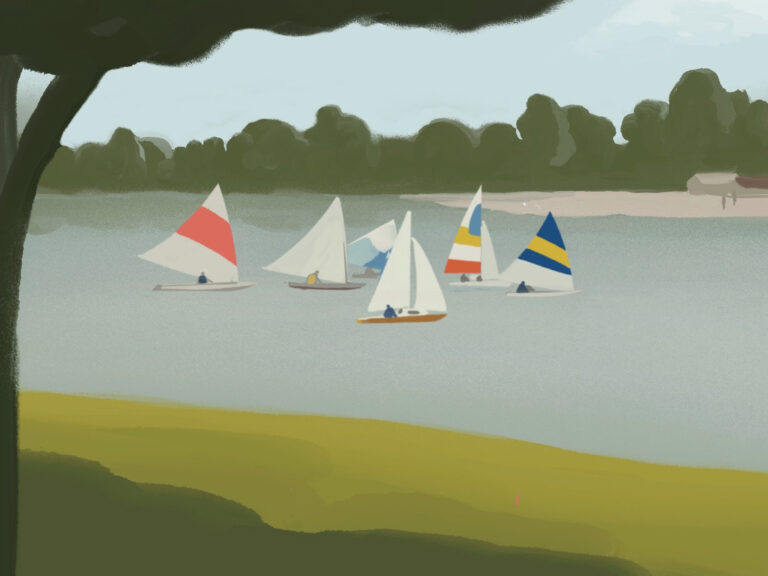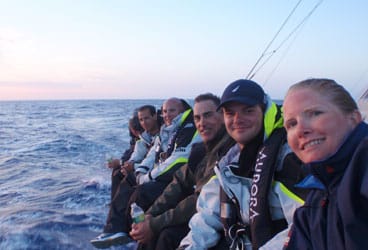
Jobson: Bermuda race
There’s a common, distinctive moment when racing from Newport to Bermuda. Your hull slips into the Gulf Stream, and suddenly, life on board feels different. Sometimes this transition is fluid. Sometimes it’s jarring, as it was, well after dark, aboard the Reichel/Pugh 66 Aurora. Foredeck crew, Ellen Quinn, was tidying up the halyards as the boat came off a wave and pounded hard into a deep trough, announcing our entrance into the Stream. Ellen, and the 19 other sailors on board our boat, knew the next 200 miles would be challenging. How challenging these miles would be depended on how well we’d planned our sprint across the Stream. Since 1906, countless racing sailors have tried to use the Gulf Stream to their advantage, trading off the discomfort of sailing across, with, and sometimes against it for a quicker route to Bermuda. With satellite imagery, the crossing is far more predictable, as is the hunt for meanders, which can swiftly carry you toward Bermuda. Finding these favorable currents, experiencing the camaraderie of a crew, the competition from boats on the horizon, and the unpredictable nature of ocean racing are at the core of racing to Bermuda.
Completing a long distance race is an accomplishment unto itself. There are always handshakes and goodwill when crossing the finish line, regardless of the result, and along the racecourse there are lessons to absorb at every turn. I’m always amazed at how rapidly things change when you are at sea: cloud formations, wave patterns, wind direction and strength, sail trim and sail selection, conversations, watch rotations, meals, and maneuvers. Everything is always in a state of flux, there’s never a moment of boredom.
My first Bermuda Race was in 1974. At the age of 24, I was the oldest crew, serving as an officer onboard a 50-foot sloop representing the U.S. Merchant Marine Academy. On Aurora, 36 years later, I was once again the elder. But this time, I moved around the deck with more care. I wisely avoided the foredeck altogether. That’s not to say I didn’t miss being up on the pointy end. As I watched my young, nimble crewmates make numerous sail changes, it brought me back to the day when running to the bow was a normal part of the routine. Today, I find it more important to monitor sail changes and maneuvers: an observer can point out mistakes before they happen.
Most often, distance race teams come together only briefly before setting off, and one of the most enjoyable elements for me is getting to know the others. Aurora used a watch system whereby each swapped watches with one other person. Every hour, new watch standers came up on deck, which I found to be less disruptive than changing a full watch. This rotation allowed me to spend time talking with everyone during the race.
People open up in refreshing ways while sitting on the windward rail. Our crew included many fascinating individuals, including Lucas Marrero, a U.S. Naval Academy graduate, who, over the past several years, has been flying missions in Iraq. Rick Deppe was onboard as our cameraman, and entertained us with great stories about shooting for the television series Deadliest Catch and filming aboard PUMA’s il mostro in the Volvo Ocean Race. Bob LaBlanca was the lucky guy to go aloft when needed. When not sailing, I learned, he’s an avid cyclist. Mike Quaglio was a varsity wrestler at the University of Wisconsin, and he was powerful on the grinders. Past Bermuda Race Chairman, John Winder, was one of our watch captains. His son Alden, 21, was onboard as well, and it was nice to hear the Father’s Day greeting during the midnight watch.
There’s great anticipation around the waterfront before an ocean race. During our pre-race crew meeting in Newport, I made it a point that we were going to have a conservative start—with 635 miles to sail there would be plenty of opportunities to make moves. When the preparatory signal sounded, however, my aggressiveness got the better of me. I wanted the pin. We were called over, and had to restart. To the collective credit of the crew I didn’t get much heat during the moment. We recovered quickly and sailed to the front of the class. Two days later, I overheard a little grumbling about the start. I am now old enough to shrug it off (I think).
About two hours into the race we passed to leeward of the 36-foot Sabre, Esmeralde. We must have looked fast as we careened past. I turned around to wave, and their entire crew waved back. I smiled, thinking about how camaraderie permeates our sport. Not long after, the mini-maxi Ran sailed by us at flank speed. They waved at us, too. Aurora was sailing at 11 knots, and Ran at 15. At one point later in the day I counted more than 100 boats on the horizon. The next day, there were two. How quickly boats separate at sea.
Aurora‘s owner is Gus Carlson, a 52-year-old executive with Thomson Reuters. Previously, he owned a Swan 46, and acquiring Aurora (née-Exile, Blue Yankee) was a big step. Carlson is Canadian and named the boat after the celestial phenomena in the Northern Sky. He was low-key throughout the race and spent considerable time at the wheel, clearly enjoying every minute of the experience.
For me, one of the great joys in life is being on the helm when a boat is in a fast groove. The trimmers make a big difference. On Aurora, Kevin Dailey and John Winder alternated trimming the main while I steered. Tig Smith worked the headsail. We never set a spinnaker. We watched the numbers carefully, though, and when everything was in alignment, the boat balanced perfectly. At times, I experimented with steering by watching the angle of heel, wind and waves, and not the instruments. After a while, I concluded it was best to use every reference.
The MVP on any raceboat is the cook. On Aurora, Vicki Vandamm spent weeks preparing the menu and food. Think about the challenge of feeding 20 crew three times a day, with copious snacks in between. She used containers instead of plates or bowls to pass the food up on deck, and nothing ever spilled. And she never stopped smiling. Two other women were on board—Ellen Quinn and Kyra Goldsmith. They worked the foredeck and the mast area, and there was never a job to big or small. Watching them perform their tasks with precision made me wonder how we can encourage more women to take up ocean racing.
Our onboard speed wizard was sailmaker Steve Benjamin, who was a veteran of sailing on this boat with the previous owner. Benji (as everyone calls him) was College Sailor of Year at Yale in 1978. In 1984, he won a silver medal in the Olympics racing 470s. Benji is tireless while racing. Under the Cruising Club of America’s race rules he was unable to steer because he’s a professional, but he was invaluable. I really enjoyed our strategy sessions along with Benji and navigator Brian O’Farrell, for which we used a computer program to overlay the forecast with three versions of what was supposed to happen in the Stream. It amazed me that every prediction arrived on cue. With such technology, the luck element surely has diminished. In 1974 we used a sextant to navigate and struggled with a weather fax. Now we go to the Internet for nearly real-time weather updates.
One of the most important attributes of any crew is having a good attitude. Aurora‘s crew was game for anything. Not a single complaint was uttered throughout the race (with the exception of our start), even as we pounded for hours in rough seas.
When it’s rough, you anticipate the end, but things change for the better soon enough. One night the pounding swells made one of our crew seasick. I watched with sympathy because I’ve had the same experience many times. I’ve learned over the years that steering is the best remedy, so I surprised the stricken sailor with a suggestion to get on the wheel. The seasickness quickly abated after 20 minutes of steering.
As is always the case, there was great excitement onboard as St. David’s Lighthouse popped up on the horizon. We were sailing fast on a close reach, but just 5 miles out, we sailed under a thunderhead, and the wind evaporated. Carlson had been steering for the past 11 miles, and now agony. It took an hour to become unstuck, but we finally crossed the finish 71 hours after starting in Newport. The hardship of the Gulf Stream was long forgotten by the time the boat was cleaned up and we entered the harbor. The large maxi fleet had arrived several hours earlier, but there was still an exuberant feeling of accomplishment as we pulled alongside the dock at the Royal Bermuda YC. The lines were barely taut before there was talk of the next race in two years. Ocean racing has a way of drawing us back.


